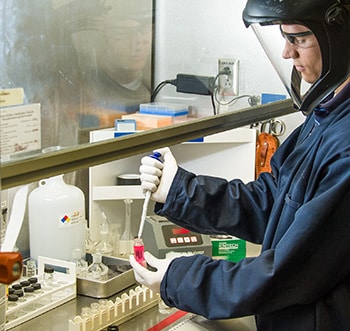Tritium Stewardship
Since the inception of the Savannah River Site, the Savannah River National Laboratory has supported the National Nuclear Security Agency defense programs mission. Currently, most SRNL programs support the SRS tritium mission. Modern nuclear weapons use a concept called gas boosting to increase the yield of a nuclear weapon. Tritium and deuterium are delivered to the weapon primary, leading to fusion reactions and a release of neutrons. These added neutrons collide with fissile material and cause fission reactions. The rate of fission is increased to where more material is able to undergo fission before the weapon’s pit explosively disassembles and is no longer critical. This makes more efficient use of the available fissile material and increases the amount of energy released by the pit.
Because tritium decays with a half-life of 12.3 years, weapons reservoirs have a limited life and must be periodically replaced. Reservoirs that have exceeded their useful lives are returned to the Savannah River Site and are unloaded. Hydrogen isotopes generated as part of the aging cycle are removed through a process invented at SRNL, allowing for pure streams of tritium and deuterium that can be reused.
Associated SRNL competencies and capabilities include:

Tritium and Reservoir Processing
- Extraction
- Purification
- Storage
- Transportation
- Isotope Separation
- Reservoir Loading and Finishing
Gas Transfer System Surveillance
- Test Methods
- Test Equipment
- Performance Tests
- Destructive Examinations
- Test Anomaly Investigation
- Assess & Report Performance
Gas Transfer System R&D
- Tritium Experiments
- Materials Selection & Development
- Prototype Testing
- Loading & Unloading Processes
Support the Broader National Security Mission
- Nonproliferation
- Intelligence
- Fusion Energy Research
- Helium-3
- Law Enforcement
- Emergency Response
- Medical Isotopes